
- 阻害剤
- 研究分野別
- PI3K/Akt/mTOR
- Epigenetics
- Methylation
- Immunology & Inflammation
- Protein Tyrosine Kinase
- Angiogenesis
- Apoptosis
- Autophagy
- ER stress & UPR
- JAK/STAT
- MAPK
- Cytoskeletal Signaling
- Cell Cycle
- TGF-beta/Smad
- 化合物ライブラリー
- Popular Compound Libraries
- Customize Library
- Clinical and FDA-approved Related
- Bioactive Compound Libraries
- Inhibitor Related
- Natural Product Related
- Metabolism Related
- Cell Death Related
- By Signaling Pathway
- By Disease
- Anti-infection and Antiviral Related
- Neuronal and Immunology Related
- Fragment and Covalent Related
- FDA-approved Drug Library
- FDA-approved & Passed Phase I Drug Library
- Preclinical/Clinical Compound Library
- Bioactive Compound Library-I
- Bioactive Compound Library-II
- Kinase Inhibitor Library
- Express-Pick Library
- Natural Product Library
- Human Endogenous Metabolite Compound Library
- Alkaloid Compound LibraryNew
- Angiogenesis Related compound Library
- Anti-Aging Compound Library
- Anti-alzheimer Disease Compound Library
- Antibiotics compound Library
- Anti-cancer Compound Library
- Anti-cancer Compound Library-Ⅱ
- Anti-cancer Metabolism Compound Library
- Anti-Cardiovascular Disease Compound Library
- Anti-diabetic Compound Library
- Anti-infection Compound Library
- Antioxidant Compound Library
- Anti-parasitic Compound Library
- Antiviral Compound Library
- Apoptosis Compound Library
- Autophagy Compound Library
- Calcium Channel Blocker LibraryNew
- Cambridge Cancer Compound Library
- Carbohydrate Metabolism Compound LibraryNew
- Cell Cycle compound library
- CNS-Penetrant Compound Library
- Covalent Inhibitor Library
- Cytokine Inhibitor LibraryNew
- Cytoskeletal Signaling Pathway Compound Library
- DNA Damage/DNA Repair compound Library
- Drug-like Compound Library
- Endoplasmic Reticulum Stress Compound Library
- Epigenetics Compound Library
- Exosome Secretion Related Compound LibraryNew
- FDA-approved Anticancer Drug LibraryNew
- Ferroptosis Compound Library
- Flavonoid Compound Library
- Fragment Library
- Glutamine Metabolism Compound Library
- Glycolysis Compound Library
- GPCR Compound Library
- Gut Microbial Metabolite Library
- HIF-1 Signaling Pathway Compound Library
- Highly Selective Inhibitor Library
- Histone modification compound library
- HTS Library for Drug Discovery
- Human Hormone Related Compound LibraryNew
- Human Transcription Factor Compound LibraryNew
- Immunology/Inflammation Compound Library
- Inhibitor Library
- Ion Channel Ligand Library
- JAK/STAT compound library
- Lipid Metabolism Compound LibraryNew
- Macrocyclic Compound Library
- MAPK Inhibitor Library
- Medicine Food Homology Compound Library
- Metabolism Compound Library
- Methylation Compound Library
- Mouse Metabolite Compound LibraryNew
- Natural Organic Compound Library
- Neuronal Signaling Compound Library
- NF-κB Signaling Compound Library
- Nucleoside Analogue Library
- Obesity Compound Library
- Oxidative Stress Compound LibraryNew
- Phenotypic Screening Library
- PI3K/Akt Inhibitor Library
- Protease Inhibitor Library
- Protein-protein Interaction Inhibitor Library
- Pyroptosis Compound Library
- Small Molecule Immuno-Oncology Compound Library
- Mitochondria-Targeted Compound LibraryNew
- Stem Cell Differentiation Compound LibraryNew
- Stem Cell Signaling Compound Library
- Natural Phenol Compound LibraryNew
- Natural Terpenoid Compound LibraryNew
- TGF-beta/Smad compound library
- Traditional Chinese Medicine Library
- Tyrosine Kinase Inhibitor Library
- Ubiquitination Compound Library
-
Cherry Picking
You can personalize your library with chemicals from within Selleck's inventory. Build the right library for your research endeavors by choosing from compounds in all of our available libraries.
Please contact us at info@selleck.co.jp to customize your library.
You could select:
- 抗体
- 新製品
- お問い合わせ
HIV Protease
亜型選択性的な製品
HIV Protease製品
- All (24)
- HIV Protease阻害剤 (24)
- 新製品
| 製品コード | 製品名称 | 製品説明 | 文献中Selleckの製品使用例 | お客様のフィードバック |
|---|---|---|---|---|
| S1030 | Panobinostat (LBH589) | Panobinostat (LBH589, NVP-LBH589) is a novel broad-spectrum HDAC inhibitor with IC50 of 5 nM in a cell-free assay. Panobinostat (LBH589) induces autophagy and apoptosis. Panobinostat effectively disrupts HIV latency in vivo. Phase 3. |
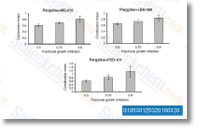
|
|
| S6999 | Chloroquine | Chloroquine is an antimalarial drug and autophagy/lysosome inhibitor. Chloroquine also suppresses Toll-like receptor-9 (TLR9) protein expression. Chloroquine is highly effective agianst SARS-CoV-2 (COVID-19) infection with EC50 of 1.13 μM in Vero E6 cells. Chloroquine has anti-HIV-1 activity. | ||
| S1380 | Lopinavir (ABT-378) | Lopinavir (ABT-378) is a potent HIV protease inhibitor with Ki of 1.3 pM in a cell-free assay. |
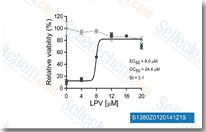
|
|
| S1185 | Ritonavir | Ritonavir is a Cytochrome P450 3A and Protease Inhibitor; Also inhibits Cytochrome P450 2D6, P-Glycoprotein and induces Cytochrome P450 2C19, Cytochrome P450 1A2, Cytochrome P450 2C9, Cytochrome P450 2B6 and UDP Glucuronosyltransferases. Ritonavir induces apoptosis. |
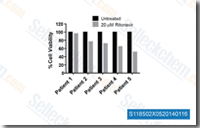
|
|
| S7381 | Pepstatin A | Pepstatin A (Pepstatin) is a potent aspartic protease inhibitor, and also inhibits HIV replication. Pepstatin A is also an inhibitor of cathepsins D and cathepsins E. Pepstatin A inhibits autophagy by suppressing lysosomal proteases. | ||
| S4282 | Nelfinavir Mesylate | Nelfinavir Mesylate is a potent HIV protease inhibitor with Ki of 2 nM. | ||
| S1457 | Atazanavir (BMS-232632) Sulfate | Atazanavir Sulfate (BMS-232632-05, Reyataz) is a HIV protease inhibitor with Ki of 2.66 nM in a cell-free assay. |
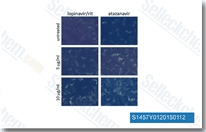
|
|
| S4662 | Atazanavir | Atazanavir (Latazanavir, Zrivada, Reyataz, BMS-232632) is an azapeptide and HIV-protease inhibitor that is used in the treatment of HIV infections and AIDS in combination with other anti-HIV agents. Atazanavir is a substrate and inhibitor of cytochrome P450 isozyme 3A (CYP3A4) and an inhibitor and inducer of P-glycoprotein. | ||
| S1620 | Darunavir Ethanolate | Darunavir Ethanolate (TMC-114, UIC 94017) is a nonpeptidic HIV protease inhibitor, used to treat HIV infection. |
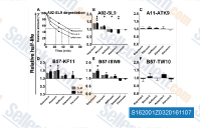
|
|
| S5250 | Darunavir | Darunavir (TMC114,DRV) is a nonpeptidic HIV protease inhibitor, used to treat HIV infection. | ||
| S9567 | Indinavir Sulfate | Indinavir sulfate (Crixivan, L-735524, MK-639) is a specific and potent inhibitor of HIV-1 protease and is widely used in the treatment of AIDS. | ||
| S1639 | Amprenavir (VX-478) | Amprenavir (VX-478, 141W94, KVX-478) is a potent PXR-selective agonist, and an HIV protease inhibitor, used to treat HIV. | ||
| S2319 | Limonin | Limonin is a triterpenoid enriched in citrus fruits, which has antivirus and antitumor ability. | ||
| S6625 | Temsavir (BMS-626529) | Temsavir (BMS-626529) is a novel small-molecule HIV-1 attachment inhibitor active against both CCR5- and CXCR4-tropic viruses. | ||
| S3494 | Vicriviroc maleate | Vicriviroc maleate(SCH-417690 maleate,SCH-D maleate) is a potent, selective, oral bioavailable and CNS penetrated antagonist of CCR5, with a Ki of 2.5 nM, and also inhibits HIV-1 in PBMC cells. | ||
| S6581 | Fosamprenavir calcium salt | Fosamprenavir(GW433908G) is a pro-drug of the protease inhibitor and antiretroviral drug amprenavir. It is used for the treatment of HIV-1 infections. | ||
| S3287 | Rosamultin | Rosamultin is a 19 α-hydroxyursane-type triterpenoid isolated from Potentilla anserina L. that inhibits HIV-1 protease. Rosamultin has protective effects on H2O2-induced oxidative damage and apoptosis. | ||
| S9010 | Bevirimat | Bevirimat (MPC-4326, PA-457, YK-FH312), the prototype Human Immunodeficiency Virus type 1 (HIV-1) maturation inhibitor, is highly potent in cell culture and efficacious in HIV-1 infected patients. | ||
| S9625 | Saquinavir (Ro 31-8959) | Saquinavir (Ro 31-8959,SAQ) is a potent and selective inhibitor of HIV proteinase with a mean IC50 of 2.7 nM in JM cells. | ||
| S6929 | Dextran sulfate sodium (DSS) | Dextran sulfate sodium (DSS) is a potent and selective inhibitor of human immunodeficiency virus type 1 (HIV-1) in vitro that inhibits virus adsorption to the host cells.Dextran sulfate sodium (DSS) can be used to induce animal models of Enteritis, Ulcerative Colitis. | ||
| E0943 | NBD-556 | NBD-556 is a novel human immunodeficiency virus type 1 (HIV-1) entry inhibitor that block the gp120-CD4 interaction. | ||
| S9633 | GS-6207 | GS-6207 (Lenacapavir) is a HIV-1 capsid inhibitor. It shows anti-HIV activity with an EC50 of 0.1 nM in MT-4 cells. | ||
| E4466 | Saquinavir Mesylate | Saquinavir mesylate (Ro 31-8959/003) is a potent inhibitor of HIV Protease used in antiretroviral therapy. It blocks proteolysis of polyproteins containing either wild-type or single-chain dimer retroviral proteinase (PR). | ||
| E1243 | Azvudine | Azvudine (RO-0622) is a novel nucleoside reverse transcriptase inhibitor with antiviral activity against human immunodeficiency virus (HIV), hepatitis B virus (HBV) and hepatitis C virus (HCV), potently inhibits HIV-1 (EC50 range 0.03 to 6.92 nM) and HIV-2 (EC50s ranging from 0.018 to 0.025 nM). | ||
| S1030 | Panobinostat (LBH589) | Panobinostat (LBH589, NVP-LBH589) is a novel broad-spectrum HDAC inhibitor with IC50 of 5 nM in a cell-free assay. Panobinostat (LBH589) induces autophagy and apoptosis. Panobinostat effectively disrupts HIV latency in vivo. Phase 3. |

|
|
| S6999 | Chloroquine | Chloroquine is an antimalarial drug and autophagy/lysosome inhibitor. Chloroquine also suppresses Toll-like receptor-9 (TLR9) protein expression. Chloroquine is highly effective agianst SARS-CoV-2 (COVID-19) infection with EC50 of 1.13 μM in Vero E6 cells. Chloroquine has anti-HIV-1 activity. | ||
| S1380 | Lopinavir (ABT-378) | Lopinavir (ABT-378) is a potent HIV protease inhibitor with Ki of 1.3 pM in a cell-free assay. |

|
|
| S1185 | Ritonavir | Ritonavir is a Cytochrome P450 3A and Protease Inhibitor; Also inhibits Cytochrome P450 2D6, P-Glycoprotein and induces Cytochrome P450 2C19, Cytochrome P450 1A2, Cytochrome P450 2C9, Cytochrome P450 2B6 and UDP Glucuronosyltransferases. Ritonavir induces apoptosis. |

|
|
| S7381 | Pepstatin A | Pepstatin A (Pepstatin) is a potent aspartic protease inhibitor, and also inhibits HIV replication. Pepstatin A is also an inhibitor of cathepsins D and cathepsins E. Pepstatin A inhibits autophagy by suppressing lysosomal proteases. | ||
| S4282 | Nelfinavir Mesylate | Nelfinavir Mesylate is a potent HIV protease inhibitor with Ki of 2 nM. | ||
| S1457 | Atazanavir (BMS-232632) Sulfate | Atazanavir Sulfate (BMS-232632-05, Reyataz) is a HIV protease inhibitor with Ki of 2.66 nM in a cell-free assay. |

|
|
| S4662 | Atazanavir | Atazanavir (Latazanavir, Zrivada, Reyataz, BMS-232632) is an azapeptide and HIV-protease inhibitor that is used in the treatment of HIV infections and AIDS in combination with other anti-HIV agents. Atazanavir is a substrate and inhibitor of cytochrome P450 isozyme 3A (CYP3A4) and an inhibitor and inducer of P-glycoprotein. | ||
| S1620 | Darunavir Ethanolate | Darunavir Ethanolate (TMC-114, UIC 94017) is a nonpeptidic HIV protease inhibitor, used to treat HIV infection. |

|
|
| S5250 | Darunavir | Darunavir (TMC114,DRV) is a nonpeptidic HIV protease inhibitor, used to treat HIV infection. | ||
| S9567 | Indinavir Sulfate | Indinavir sulfate (Crixivan, L-735524, MK-639) is a specific and potent inhibitor of HIV-1 protease and is widely used in the treatment of AIDS. | ||
| S1639 | Amprenavir (VX-478) | Amprenavir (VX-478, 141W94, KVX-478) is a potent PXR-selective agonist, and an HIV protease inhibitor, used to treat HIV. | ||
| S2319 | Limonin | Limonin is a triterpenoid enriched in citrus fruits, which has antivirus and antitumor ability. | ||
| S6625 | Temsavir (BMS-626529) | Temsavir (BMS-626529) is a novel small-molecule HIV-1 attachment inhibitor active against both CCR5- and CXCR4-tropic viruses. | ||
| S3494 | Vicriviroc maleate | Vicriviroc maleate(SCH-417690 maleate,SCH-D maleate) is a potent, selective, oral bioavailable and CNS penetrated antagonist of CCR5, with a Ki of 2.5 nM, and also inhibits HIV-1 in PBMC cells. | ||
| S6581 | Fosamprenavir calcium salt | Fosamprenavir(GW433908G) is a pro-drug of the protease inhibitor and antiretroviral drug amprenavir. It is used for the treatment of HIV-1 infections. | ||
| S3287 | Rosamultin | Rosamultin is a 19 α-hydroxyursane-type triterpenoid isolated from Potentilla anserina L. that inhibits HIV-1 protease. Rosamultin has protective effects on H2O2-induced oxidative damage and apoptosis. | ||
| S9010 | Bevirimat | Bevirimat (MPC-4326, PA-457, YK-FH312), the prototype Human Immunodeficiency Virus type 1 (HIV-1) maturation inhibitor, is highly potent in cell culture and efficacious in HIV-1 infected patients. | ||
| S9625 | Saquinavir (Ro 31-8959) | Saquinavir (Ro 31-8959,SAQ) is a potent and selective inhibitor of HIV proteinase with a mean IC50 of 2.7 nM in JM cells. | ||
| S6929 | Dextran sulfate sodium (DSS) | Dextran sulfate sodium (DSS) is a potent and selective inhibitor of human immunodeficiency virus type 1 (HIV-1) in vitro that inhibits virus adsorption to the host cells.Dextran sulfate sodium (DSS) can be used to induce animal models of Enteritis, Ulcerative Colitis. | ||
| E0943 | NBD-556 | NBD-556 is a novel human immunodeficiency virus type 1 (HIV-1) entry inhibitor that block the gp120-CD4 interaction. | ||
| S9633 | GS-6207 | GS-6207 (Lenacapavir) is a HIV-1 capsid inhibitor. It shows anti-HIV activity with an EC50 of 0.1 nM in MT-4 cells. | ||
| E4466 | Saquinavir Mesylate | Saquinavir mesylate (Ro 31-8959/003) is a potent inhibitor of HIV Protease used in antiretroviral therapy. It blocks proteolysis of polyproteins containing either wild-type or single-chain dimer retroviral proteinase (PR). | ||
| E1243 | Azvudine | Azvudine (RO-0622) is a novel nucleoside reverse transcriptase inhibitor with antiviral activity against human immunodeficiency virus (HIV), hepatitis B virus (HBV) and hepatitis C virus (HCV), potently inhibits HIV-1 (EC50 range 0.03 to 6.92 nM) and HIV-2 (EC50s ranging from 0.018 to 0.025 nM). |
